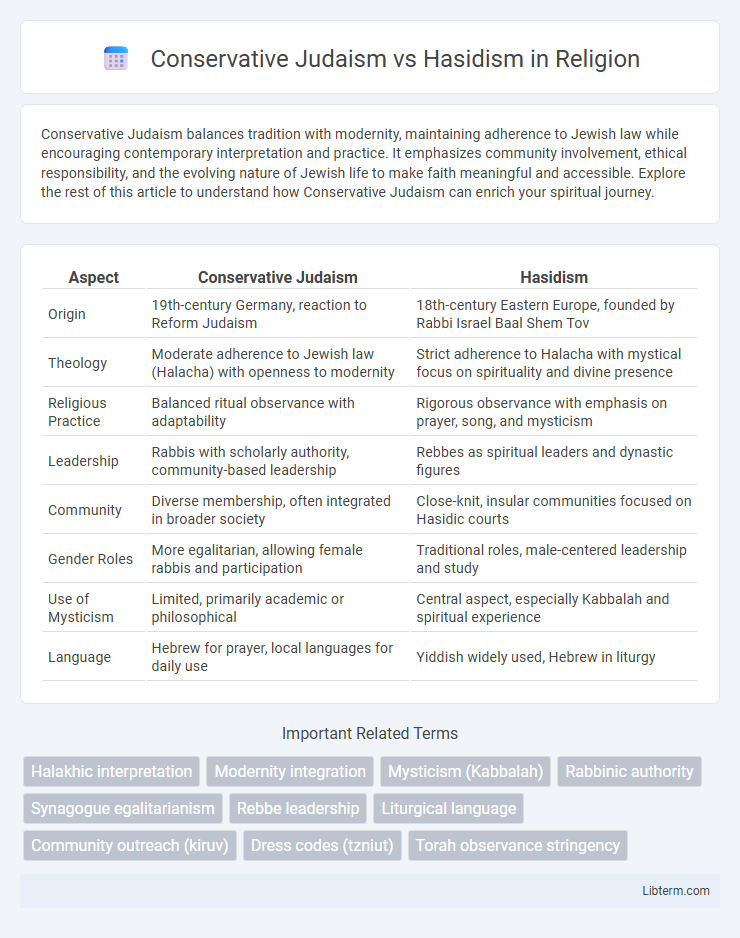Conservative Judaism balances tradition with modernity, maintaining adherence to Jewish law while encouraging contemporary interpretation and practice. It emphasizes community involvement, ethical responsibility, and the evolving nature of Jewish life to make faith meaningful and accessible. Explore the rest of this article to understand how Conservative Judaism can enrich your spiritual journey.
Table of Comparison
| Aspect | Conservative Judaism | Hasidism |
|---|---|---|
| Origin | 19th-century Germany, reaction to Reform Judaism | 18th-century Eastern Europe, founded by Rabbi Israel Baal Shem Tov |
| Theology | Moderate adherence to Jewish law (Halacha) with openness to modernity | Strict adherence to Halacha with mystical focus on spirituality and divine presence |
| Religious Practice | Balanced ritual observance with adaptability | Rigorous observance with emphasis on prayer, song, and mysticism |
| Leadership | Rabbis with scholarly authority, community-based leadership | Rebbes as spiritual leaders and dynastic figures |
| Community | Diverse membership, often integrated in broader society | Close-knit, insular communities focused on Hasidic courts |
| Gender Roles | More egalitarian, allowing female rabbis and participation | Traditional roles, male-centered leadership and study |
| Use of Mysticism | Limited, primarily academic or philosophical | Central aspect, especially Kabbalah and spiritual experience |
| Language | Hebrew for prayer, local languages for daily use | Yiddish widely used, Hebrew in liturgy |
Overview of Conservative Judaism and Hasidism
Conservative Judaism balances adherence to traditional Jewish law with modern interpretations, promoting adaptability and inclusivity within religious practice. Hasidism emphasizes mysticism, spiritual experience, and the leadership of charismatic rebbes, focusing on joyous worship and communal closeness. Both movements maintain commitment to Torah observance but differ in ritual strictness and theological emphasis.
Historical Origins and Development
Conservative Judaism originated in the 19th century as a middle ground between Orthodox and Reform Judaism, emphasizing the preservation of Jewish law while allowing for modern interpretations. Hasidism emerged in the 18th century in Eastern Europe, founded by Rabbi Israel Baal Shem Tov, promoting mysticism, spiritual revival, and joyous religious practice. Both movements developed in response to different social and religious challenges faced by Jewish communities in Europe.
Core Beliefs and Philosophies
Conservative Judaism emphasizes balancing traditional Jewish law (Halacha) with modernity, allowing for adaptation while maintaining adherence to Torah principles and rabbinic interpretations. Hasidism centers on mysticism, spiritual joy, and a close, personal relationship with God, guided by a Rebbe who acts as a spiritual leader and conduit. While Conservative Judaism engages with secular scholarship and egalitarian practices, Hasidism prioritizes communal devotion, prayer fervor, and the mystical teachings found in Kabbalah.
Interpretation of Jewish Law (Halacha)
Conservative Judaism adopts a historical-critical approach to Halacha, allowing for adaptations in Jewish law while maintaining its core principles, emphasizing a balance between tradition and modernity. Hasidism adheres strictly to Halacha, interpreting the law through the lens of mystical experience and the teachings of Hasidic masters, prioritizing fervent spirituality and community customs. Both movements respect the authority of Halacha, yet Conservative Judaism tends to embrace legal flexibility, whereas Hasidism underscores unwavering observance rooted in mystical tradition.
Worship Practices and Rituals
Conservative Judaism blends traditional Jewish law with modern interpretations, allowing for mixed-gender seating and the use of musical instruments during services to enhance worship. Hasidism emphasizes fervent prayer, often including mystical teachings, with male-only seating and repetitive, melodic singing (nigunim) to achieve spiritual elevation. Ritual practices in Hasidism are deeply rooted in the teachings of the Baal Shem Tov, contrasting with Conservative Judaism's more flexible approach to halakhic observance.
Role of Community and Leadership
Conservative Judaism emphasizes a balance between tradition and modernity, promoting rabbinic authority while encouraging community participation in decision-making processes. Hasidism centers on a charismatic Rebbe whose spiritual leadership deeply influences community life and fosters intense group cohesion through shared rituals and mystical experiences. Community in Conservative Judaism tends to be structured around synagogue membership and educational programs, whereas Hasidic communities integrate social, religious, and everyday life under the Rebbe's guidance, creating a tightly knit and insular environment.
Attitudes toward Modernity and Secular Society
Conservative Judaism seeks to balance traditional Jewish law with contemporary life, allowing for adaptation to modern values and secular knowledge while maintaining halachic integrity. Hasidism emphasizes strict adherence to spiritual and communal traditions, often exhibiting resistance to secular influences and modernity to preserve religious authenticity. The differing attitudes towards secular society reflect Conservative Judaism's openness to engagement versus Hasidism's focus on insular, devout communal life.
Gender Roles and Participation
Conservative Judaism maintains gender egalitarianism by allowing women to participate equally in religious rituals, including being counted in a minyan and serving as rabbis, reflecting progressive interpretations of Halacha. Hasidism typically observes traditional gender roles, emphasizing male leadership in religious services while women engage in distinct spiritual roles and community responsibilities, often within stricter Halachic frameworks. These differences highlight the varying approaches to gender inclusion and religious participation between Conservative Judaism's modernist stance and Hasidism's adherence to Orthodox customs.
Dress Codes and Outward Appearance
Conservative Judaism generally adopts a modern approach to dress codes, encouraging modest attire while allowing personal discretion, and does not typically mandate specific garments for daily wear. Hasidism emphasizes distinctive dress codes rooted in tradition, including black suits, white shirts, and specific hats such as shtreimels or spodik for men, along with modest dresses and head coverings for women, symbolizing their spiritual identity and community affiliation. These outward appearances serve as visible markers of religious commitment and cultural continuity within Hasidic communities.
Global Influence and Demographic Trends
Conservative Judaism, with its global network of synagogues and educational institutions, maintains significant influence particularly in North America and Israel, attracting adherents seeking a balance between tradition and modernity. Hasidism, rooted in Eastern European mysticism, has experienced demographic growth primarily through its tightly-knit communities in New York, Israel, and parts of Europe, emphasizing spiritual fervor and communal cohesion. While Conservative Judaism engages broadly with modern societal issues, Hasidism's demographic trends reflect insularity and rapid population growth driven by high birth rates within its adherents.
Conservative Judaism Infographic

 libterm.com
libterm.com